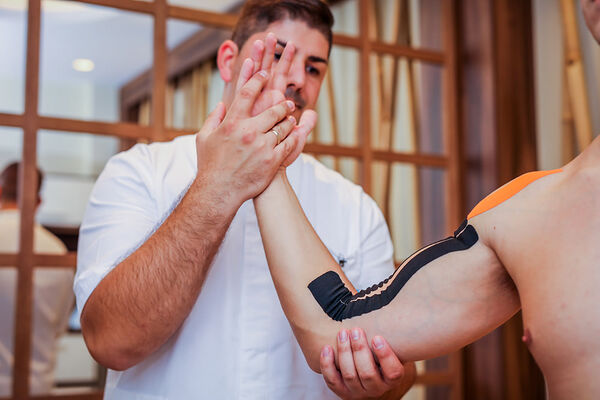
What is kinesiotaping?
Neuromuscular kinesio taping is a method through which we may cause skin stimulation by providing support to the muscles and keeping track of body movements, all with the aim of self-healing. Each patient is approached individually, and consequently, the application of the technique is adjusted to suit each client.
The muscles determine body movements, control the vascular and lymphatic circulation and body temperature, therefore, the changes in the muscles functions may lead to a range of different symptomatologies. Therapeutic effects can be produced by stimulating the skin, and they need not be local, but can instead influence the deeper sections of the musculoskeletal system as well.

When is it applied?
The kinesio taping method is used to:
- provide support to the muscles
- improve contraction of weakened muscles
- reduce muscle fatigue
- decrease excess stretching and excess contraction of the muscles
- reduce the chance of cramps and possible muscle injuries
- increase the range of movement
- relieve the pain
- impede blood and lymph stasis (thus improving circulation)
- reduce inflammation
- decrease oversensitivity to pain in skin and muscles
- reduce the irritation of touch and pain receptors — thus lessening the pain
- fix a variety of joint problems
- fix a variety of lymphatic drainage problems
- fix certain functioning problems
- decrease scars and prevent keloid formation
General characteristics of the application
The strip is waterproof and, with its micromovements, stimulates the dermal and subdermal receptors, and consequently the entire nervous system which conditions the muscle reflex. In addition to this, with the help of skin stimulation, the tape reduces lymph and blood stasis, enhances local microcirculation and facilitates swelling reduction. By puckering the skin, intercellular spaces are increased, blood flow and fluid absorption is improved, and the pressure in the subcutaneous layer is decreased. It is possible to treat a very wide range of diseases using these strips, therefore, the therapy must be carried out only by specially trained physical therapists and doctors. The kinesio taping therapy is a part of a therapeutic protocol alongside other therapy procedures, but it can also be applied in between other procedures if the patient is not able to come every day. Depending on the localization of the problem at hand, it is possible to apply kinesio taping therapy at the same time as the other methods of physical therapy. The strips do not limit movements, on the contrary, they support it, so it is advisable to exercise and carry out kinesiotherapy methods while the tapes are being applied.
How is it applied?
In kinesio taping method, a specially designed strip, which is very similar to the skin itself in its characteristics (weight, thickness, elasticity), is used. The tape does not contain any pharmacological agents. The glue located on its surfaces is hypoallergenic, but the strip itself allows the skin to breathe to the fullest. It is waterproof, thus the patients are able to freely take a shower while the strip is applied. It ought to be carried for three to five days after which it is completely removed from the skin. Kinesio taping method, due to all these characteristics of the strip, can be used an unlimited amount of times without any harmful effects.


